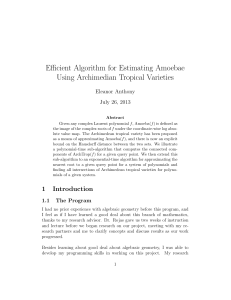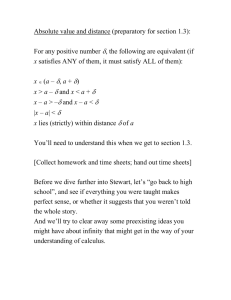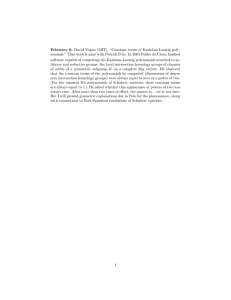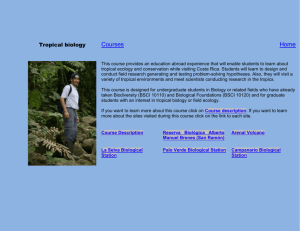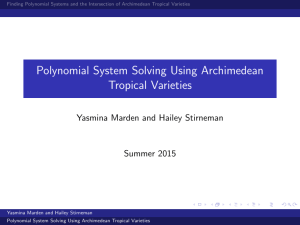Efficient Algorithm for Estimating Amoebae Using Archimedian Tropical Varieties Sheridan Grant
advertisement
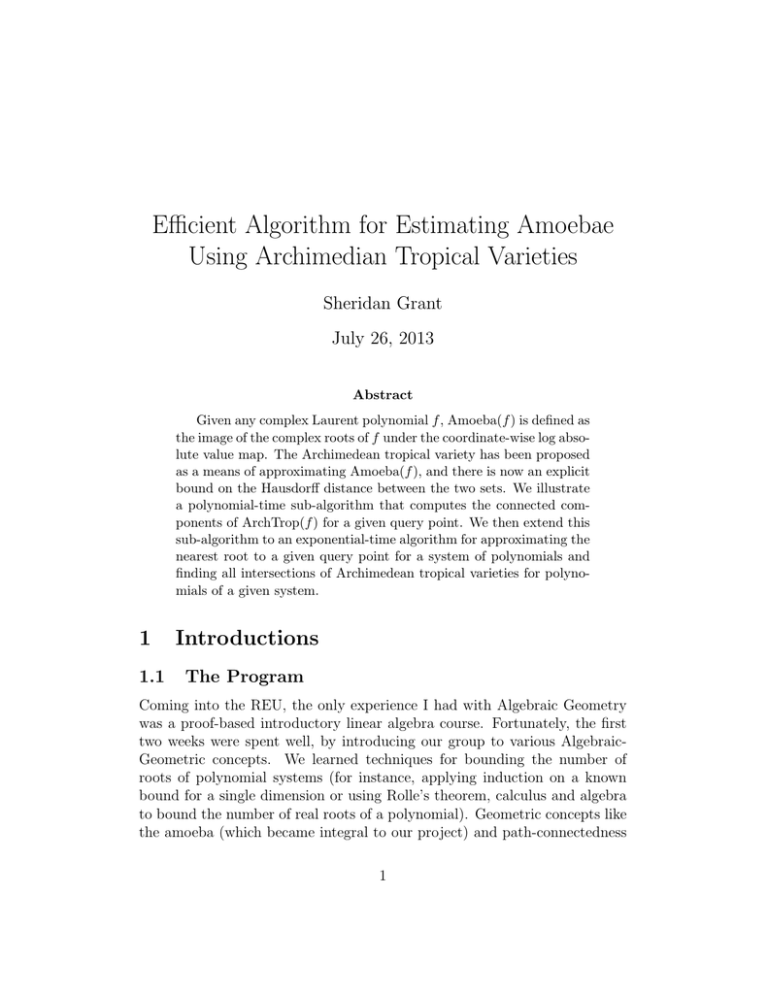
Efficient Algorithm for Estimating Amoebae
Using Archimedian Tropical Varieties
Sheridan Grant
July 26, 2013
Abstract
Given any complex Laurent polynomial f , Amoeba(f ) is defined as
the image of the complex roots of f under the coordinate-wise log absolute value map. The Archimedean tropical variety has been proposed
as a means of approximating Amoeba(f ), and there is now an explicit
bound on the Hausdorff distance between the two sets. We illustrate
a polynomial-time sub-algorithm that computes the connected components of ArchTrop(f ) for a given query point. We then extend this
sub-algorithm to an exponential-time algorithm for approximating the
nearest root to a given query point for a system of polynomials and
finding all intersections of Archimedean tropical varieties for polynomials of a given system.
1
1.1
Introductions
The Program
Coming into the REU, the only experience I had with Algebraic Geometry
was a proof-based introductory linear algebra course. Fortunately, the first
two weeks were spent well, by introducing our group to various AlgebraicGeometric concepts. We learned techniques for bounding the number of
roots of polynomial systems (for instance, applying induction on a known
bound for a single dimension or using Rolle’s theorem, calculus and algebra
to bound the number of real roots of a polynomial). Geometric concepts like
the amoeba (which became integral to our project) and path-connectedness
1
were discussed, among other things.
I chose the Tropical Geometry project as I thought my programming
experience would allow me to contribute to the algorithmic aspects of the
project, especially as a major goal of the project was to find fast/polynomial
time algorithms. Sure enough, Matlab programming became a daily job, allowing me to add a sixth programming language to my lexicon.
We began the project with a “naive” algorithm that used the exponentialtime convex hull algorithm to compute the entire Archimedean Newton polytope and, from there, the entire Archimedean tropical variety. Though the
algorithm was inefficient, it was a good way to learn Matlab, as well as get
a feel for the eccentric geometric structures that we would be working with
going forward. Also, the ability to fully depict Archimedean tropical varieties
in two dimensions proved useful in testing our later algorithms and in communicating the geometric concepts of our project in presentations. Following
this, we transitioned into writing our final algorithm, detailed below.
1.2
Introduction to Algebraic Geometry
The traditional means of solving poynomial systems of equations, particularly
with the use of Grobner Bases, unfortunately has a lower complexity bound
of exponential space. Polyhedral geometry can be used to approximate the
norms of roots of polynomials, a relationship first discovered by Isaac Newton
over the field C. We examine tropical geometry, specifically the Archimedean
case, as a means of linking polyhedral geometry with algebraic geometry.
1.3
Definitions
We use the abbreviations [N ] := {1, ..., N }, x := (x1 , ..., xn ), and let Conv(S)
denote the convex hull of a set S. Let us then define the function Log|x| to
±1
be (log|x1 |, ..., log|xn |) and, for any f ∈ C[x±1
)
1 , ..., xn ], we define
Pt Amoeba(f
∗ n
ai
to be {Log|x| | f (x) = 0, x ∈ (C ) }. Also, writing f (x) = i=1 Ci x with
Ci 6= 0 for all i, we define the support (or spectrum) of f to be Supp(f ) :=
{ai }i∈t , the (ordinary) Newton polytope of f to be Newt(f ) :=Conv(Supp(f )),
and the Archimedean Newton polytope of f to be ArchNewt(f ) :=Conv({(ai , −log
|ci |)}i∈t ). We also define the Archimedean tropical variety of f , denoted
2
ArchTrop(f ), to be the set of all v ∈ Rn with (v, −1) an outer normal of
a positive-dimensional face of ArchNewt(f ). Finally, given any subsets R,
S ∈ Rn , their Hausdorff distance, ∆(R, S), is defined to be the maximum of
sup inf |ρ − σ|, and sup inf |ρ − σ| where |.| denotes the usual L2 norm on Rn .
ρ∈R σ∈S
1.4
σ∈S ρ∈R
Theorem
±1
For any f ∈ C[x±1
1 , ..., xn ] with exactly t monomial terms and Newt(f ) of
dimension k, we have t ≥ k + 1 and
∆(Amoeba(f ), ArchT rop(f )) ≤ (2t − 3)log(t − 1)
Furthermore:
(0) If t = k+1 or Supp(f ) is the vertex set of Newt(f ), then (a) ArchTrop(f ) ⊆
Amoeba(f ) and (b) ArchTrop(f ) and Amoeba(f ) are homotopy equivalent.
(1) For t ≥ k + 1 we have
sup
inf
|ρ − σ| ≤ log(t − 1).
ρ∈Amoeba(f ) σ∈ArchT rop(f )
(2) Defining gt,k (x) := (x1 + 1)t−k + x2 + · · · + xk , we have
∆(Amoeba(gt,k ), ArchT rop(gt,k )) ≥ log(t − k)
2
Algorithm
An algorithm that calculates the Archimedean tropical variety intersections
lying on the connected component of the union of the Archimedean tropical
varieties that surrounds a given query point for a system of k n-dimensional
polynomial equations is detailed as follows.
P
Input: For k functions f ∈ Q[x1 , . . . xn ], written as f (x) = ti=1 Ci xai
with Ci 6= 0 for all i and the ai distinct, input each Supp(f ) concatenated
with -log|Ci | for the k polynomials and a query point, v ∈ Qn .
3
Output: A matrix consisting of the intersections of the Archimedean
tropical varieties of the k polynomials in the connected component of Rn
surrounding the query point v and a matrix consisting of the distances
from the query point, v, to the given ArchTrop intersections.
Description:
1. Using linear programming, determine which vectors
{ai , −log|Ci |} in Supp(f ), for each of the k polynomials, cannot be
written as a convex linear combination of the other vectors in the
set. I.e., for any {ak , −log|Ck |}, with k ∈ [t], α1 (ai , −log|Ci |)+· · ·+
αn (at , −log|Ct |) 6= (ak , −log|Ck |), the vector (ai , − log |ci ) does not
appear on the left hand side of the equation, and the real numbers
αi satisfy αi ≥ 0 and α1 + · · · + αn = 1. These vectors are the
vertices defining the Archimedean Newton polytope, or ArchNewt,
of the function.
2. Now determine which vertex of the ArchNewt(f ) yields the maximal inner product with the query point vector, v. Via the duality
between ArchNewt(f ) and ArchTrop(f ) this vertex will correspond
to the connected component of the ArchTrop(f) in which the given
query point, v, will lie.
3. Using a second linear program, determine which vertices of
ArchNewt(f ), when paired with the maximizing vertex, define edges
of the ArchNewt(f ) for each of the k polynomials. Consider the
midpoints of all the line segments formed by a vertex other than
the maximizing vertex being connected to the maximizing vertex.
If a midpoint cannot be written as a convex linear combination
of any vertices (other than, trivially, the two vertices it is halfway
between), the edge from which it was derived defines an outer edge
of the ArchNewt(f ). Thus, the outer edges of the hull emanating
from the maximizing vertex are found.
4
4. In a third linear program, determine which edges defining
ArchNewt(f ) for each of the k polynomials are lower edges. Subtract any > 0 from the last coordinate of the midpoint of each
edge, and minimize a variable s that is added to the last coordinate of the linear combination. If the minimum distance s the
midpoint’s last coordinate may be raised while still remaining in
the hull is less than , the midpoint originally resided on an upper
edge of the hull. If s = , the midpoint originally resided on a
lower edge of the hull. Thus, the lower edges of ArchNewt(f ) may
be determined.
5. Now, for each of the k polynomials, subtract the maximizing vertex
from each vertex vector that helps define a lower edge of ArchNewt(f )
in order to obtain the vectors that define the lower edges of each
ArchNewt(f ) of interest for the query point, v. Compute the inner
product of each of these vectors with the vector X = (x1 , x2 , . . . , xn , −1).
Setting the product less than or equal to zero, the equations for the
hyperplanes defining the connected component of the ArchTrop(f )
in which the query point lies are obtained.
6. Find all k-tuples from the k sets of lower edge vectors in ArchNewt(f) for the k polynomials. Check each n-dimensional k-tuple
for linear independence, projecting the vectors “down a dimension”
(i.e. ignoring the last coordinate).
7. Determine which of those linearly independent lower edge k-tuples
have a Minkowski sum that defines a lower face of the Minkowski
sum of the k ArchNewt(f) they help define via a linear program
similar to that in step 4.
5
8. Those k-tuples of edges whose Minkowski sums form lower faces
on the Minkowski sum of the k Archimedean Newton Polytopes
define intersections of the k Archimedean Tropical Varieties on the
connected component of the union of the k Archimedean Tropical
Varieties that surrounds the query point. Taking the dot product
of each edge in the k-tuple with (x1 , x2 , . . . , xn , −1) yields a system of k hyperplanes whose intersection is the intersection of the
Archimedean Tropical Varieties we desire. From these intersecting hyperplanes, computing the intersections and (if k = n), the
distance from v to the intersection points, is trivial.
3
3.1
Preliminary Results
The POSSO Suite
We aim to test the efficiency and accuracy of our algorithm, as well as gain
an indication of what the generalization of the Hausdorff bound in section
1.2 to arbitrary dimensions might look like. The POSSO suite provides
an excellent opportunity to do this, offering numerous polynomial systems
of varying sizes and orders that have been used in research in areas like
chemistry and economics.
3.2
Results
For the Reimer 5 and Rose systems, most roots appear to lie less than 2
units from an intersection of the system’s corresponding Archimedean tropical varieties. supa∈log |roots| inf b∈ArchT ropIntersections |a − b| initially appears to
be relatively small, being 5.3872 for “Chemequs” and 0.5012 for “Caprasse.”
However, supb∈ArchT ropIntersections inf a∈log |roots| |a − b| seems to be much larger:
111.1693 for “Chemequs” and 5.8575 for “Caprasse.”
4
4.1
Conclusion
The Project
The project is far from over. Though we have a working algorithm, we
must test it thoroughly, an endeavor that will take lots of time (both real
6
and computational). Additionally, we plan to use our algorithm to develop
heuristics for the Hausdorff distance between Archimedean Tropical Varieties
and amoebae for systems. We will also explore the algorithm’s implications
in complexity theory, perhaps specifically in the context of Steve Smale’s seventeenth problem, which calls for an average-case polynomial-time algorithm
that approximates roots of polynomial systems. In the coming semester, we
plan to write and submit for publishing a paper centered on this algorithm
with Drs. Maurice Rojas and Peter Gritzmann.
4.2
The Program
The most significant impression the REU made on we was that research is an
enjoyable and worthwhile use of time. I have always enjoyed working with
others on math, so it was natural that I would like research. I also like getting
wrapped-up in whatever I am doing, so having an enormous, difficult problem
to always be pondering is great. My feelings about graduate education are
more mixed. Over the course of the program, I learned that a graduate
mathematics education is extremely important, even if one is aiming to work
in industry rather than academia. Yet it seems to be a stressful struggle
for many students, making me think that finding a field that one is truly
passionate about is vital before attending graduate school. My hope is that,
by senior year, I will have discovered such a field.
References
[1] Martı́n Avendaño, Roman Kogan, Mounir Nisse, and J. Maurice Rojas.
Metric Estimates For Archimedean Amoeba And Tropical Hypersurfaces.
[2] Eleanor Anthony, Sheridan Grant, J. Maurice Rojas, and Alexander E.
Whatley. Polynomial-Time Ball-Amoeba Intersection.
7
